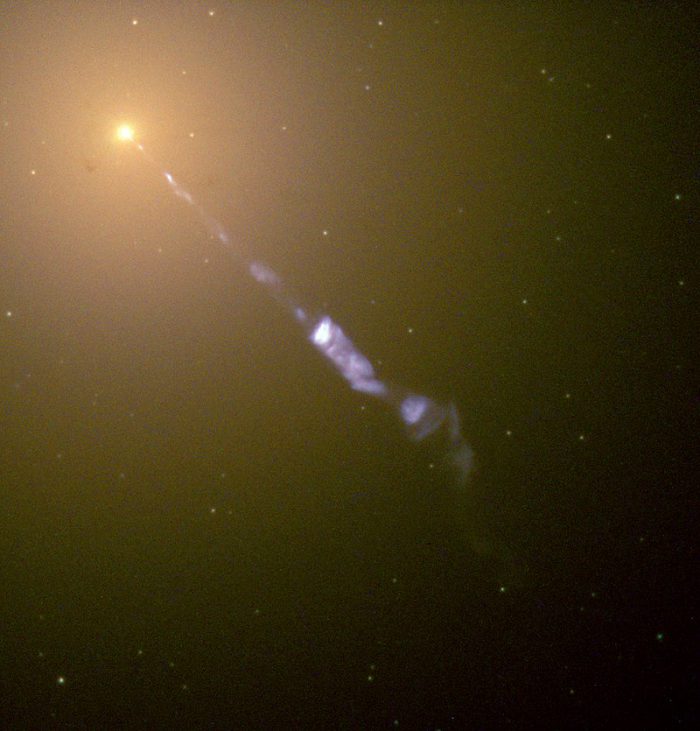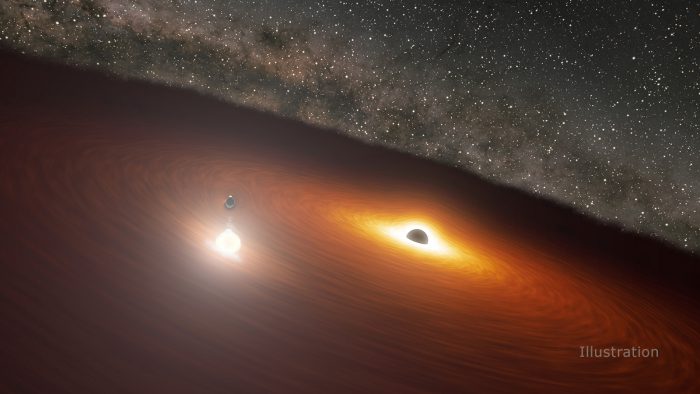Welcome back to our Science Odyssey Contest event, where we're posting STEM articles from May 2 to May 17. To enter, you can find details at the bottom of this post.
All galaxies are enormous entities, full of monstrous displays of power. Many thousands of light years across, with millions of stars centred around a supermassive black hole. But even by these standards, there are ones that really stand out from the galactic crowd.
Like OJ 287.
Though that sounds like the name of a new power smoothie, it is actually a blazar.
And though that sounds like a very stylish sports jacket, it is a galaxy that shoots a relativistic jet toward an observer (like this!).

A Hubble image of the relativistic jet of galaxy M87. (NASA/Hubble)
And though that sounds like a very practically-minded airplane, it is really a huge stream of ionized matter — travelling at nearly the speed of light — powered by an active galactic nucleus.
Yes, that does sound like a very potent, cosmic yeast-making baking additive, but it is really a super compact galactic centre with higher-than-normal luminosity, or brightness. In the case of OJ 287, this bright, bright light is powered by a double black hole.
And that, friends, is exactly what it sounds like. Two. Black. Holes.
Together.
And for the astronomers who study it, this duo has 'flare' like nothing else in the universe.
Double trouble

This graph shows the size of the two black holes of OJ 287 compared to the size of our own solar system. (NASA/Hubble)
Today, scientists believe that every galaxy has a supermassive black hole at its centre. The Milky Way's, Sagittarius A*, has a mass of (or the same amount of matter as) about 4 million suns. That sounds impressive. Which is it. Unless you're OJ 287.
Not only does this galaxy have two supermassive black holes at its centre. But they are HUGE.
The smaller of the two comes in at a mass of 150 million suns, around 37 times the size of Sgr A*. And the bigger one?
18 billion suns. That's 4,500 times the size of Sgr A*, which itself is 4 million times the mass of our Sun. (We think we need to sit down to take all this in.)
In short, if you can manage to wrap your mind around that much matter squished into such a relatively small area, then the intense brightness of OJ 287 starts to make a lot of sense.
But OJ 287 has yet another source of brilliant light. One that shines just twice every 12 years. And scientists made a big breakthrough in predicting when it happens!
Taking the plunge
OJ 287's largest black hole commands the centre of the galaxy. Swirling around it at speeds so fast that it glows with intense heat, is a wide accretion disc of stellar gases. Also orbiting the large black hole is the smaller one. But it doesn't orbit on the same plane, or pathway, as the disk.
Instead, it moves around in a very tilted, elliptical 12-year orbit that sends it crashes through the disk again and again. When sped up in the simulated video below, it looks like a dolphin taking a joyride through a whirlpool of celestial fire. Whee! Splash! Whee! Splash!
And there's even more. Because every time it passes through the disc, the collision produces a flare so brilliant, it shines as bright as a trillion suns.
Have a look below.
Beautiful, right? And one more thing.
Using data from the Spitzer Space Telescope and other sources, astronomers have been able to predict when these flares will appear within an accuracy of four hours. The last flare? July 31, 2019.
That's something that happens only twice every 12 years in a galaxy 3.5 billion light years away. And they nailed it to the day.
And if all of that doesn't blow you away like a relativistic jet shining in your face, we're just going to have to hang up our blazar and retire from active galactic nuclear duty because that's all we've got!
Contest alert
Don't miss our Science Odyssey Contest. Click HERE TO ENTER.

 This illustration shows the smaller of two black holes in the centre of galaxy OJ 287. As the black hole plunges into a disk of dust and gas, it causes an exceptionally bright flare. (NASA/JPL-Caltech)
This illustration shows the smaller of two black holes in the centre of galaxy OJ 287. As the black hole plunges into a disk of dust and gas, it causes an exceptionally bright flare. (NASA/JPL-Caltech)










That’s so cool.✔